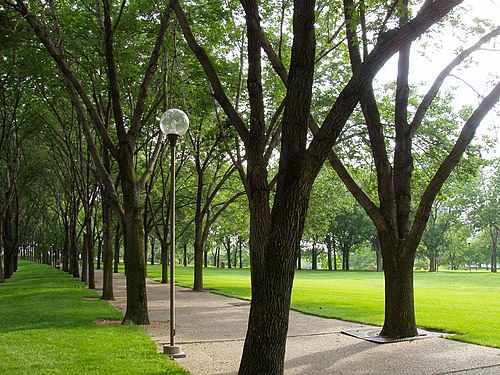Dan Kiley | |
|---|---|
 A sculpture relief of Kiley at theGateway Arch National Park inSt. Louis. | |
| Born | Daniel Urban Kiley (1912-09-02)September 2, 1912 Boston, Massachusetts, United States |
| Died | February 21, 2004(2004-02-21) (aged 91) Charlotte, Vermont, United States |
| Alma mater | Harvard University |
| Occupation | Architect |
| Spouse | Anne Lothrop Sturges |
| Children | 8 |
| Awards | Thomas Jefferson Medal in Architecture (1987) National Design Awards Lifetime Achievement (2002) |
| Projects | Gateway Arch National Park |
Daniel Urban Kiley (September 2, 1912 – February 21, 2004) was an Americanlandscape architect who worked in themodern style.[1] Kiley designed over one thousand landscape projects includingGateway Arch National Park inSt. Louis.[2]

Kiley was born in the neighborhood ofRoxbury inBoston, where his father was a construction manager. In 1930, Kiley graduated fromJamaica Plain High School. Two years later, he began a four-year apprenticeship with landscape architectWarren H. Manning, working without pay for the first year, during which he learned the fundamentals of the field and developed an interest in the role of plants in design.[3] From 1936 to 1938, Kiley was a special student in the design program atHarvard University, now theGraduate School of Design, while continuing work with Manning. Among his classmates wereGarrett Eckbo andJames C. Rose, who also became influential landscape architects. After two years, upon Manning's death and the dissolution of his practice, Kiley left Harvard without graduating. He worked briefly for theNational Park Service inConcord,New Hampshire, and later theUnited States Housing Authority, where he met architectLouis Kahn. On Kahn's advice, Kiley left the authority in 1940 to become a licensed practicing architect.
From 1943 to 1945, Kiley served in theUnited States Army as Captain in the Presentation Branch of theOffice of Strategic Services, becoming its director after architectEero Saarinen stepped down. At the end ofWorld War II, Kiley designed the courtroom where theNuremberg Trials were held. While in Europe, he visited theChâteau de Villandry and thePalace of Versailles, as well as the work ofAndré Le Nôtre, whose formality and geometric layout shaped his later classical modernist style.
Following the war, Kiley found himself as one of the only modern landscape architects in the postwar building boom. In California, his colleagues Eckbo,Thomas Church, and others were also developing and practicing in the modernist style. Kiley reestablished his practice inFranconia,New Hampshire, and later moved toCharlotte,Vermont. In 1947, in collaboration with Saarinen, Kiley entered and won the competition to design theGateway Arch National Park (then known as the Jefferson National Expansion Memorial), a high-profile project that launched his career.
Throughout Kiley's practice, he hired such designers asCheryl Barton,Miho Mazereeuw,Kevin Roche,Harry Turbott, andPeter Walker.
In 2000, the actorPaul Hopkins portrayed Kiley in theminiseriesNuremberg, featuringAlec Baldwin.
In 2013, The Cultural Landscape Foundation organized a traveling exhibition titledThe Landscape Architecture Legacy of Dan Kiley, which featured over forty newly commissioned photographs of Kiley's projects.[4]
TheHarvard UniversityGraduate School of Design has an endowed fellowship in his name: the Daniel Urban Kiley Teaching Fellowship in Landscape Architecture.[5] There is also an endowed lecture series called the Daniel Urban Kiley Lecture, which has been delivered by such designers asJulie Bargmann andJames Corner.[6]
The location of theKiley Gardens is in the Downtown Tampa area. It is an urban area surrounded by libraries, popular eating places, the University of Tampa, and business headquarters. The gardens were originally a part of the NationsBank Plaza before being built on top of an underground garage. The site has been neglected for many years and is now being supported by theCultural Landscape Foundation. The foundation is currently trying to restore the gardens to their former glory. Kiley Gardens is currently under reconstruction and partnered with members and residents of Downtown Tampa in an effort to improve its current state. The gardens are accredited by theTampa Bay Foundation for Architecture and Design. The Kiley Gardens were designed by Dan Kiley with the help of Henry Wolf. The purpose of the gardens was to create some shade in the Downtown Tampa area and more importantly create the feeling of taking a walk in the woods in such an urban setting. The pattern of the garden was set to look like the Fibonacci mathematical sequence. The sequence is meant to start with the numbers zero and one and each number after that is the sum of the two previous numbers added together. When the gardens first opened in 1988 the goal was to have many more trees covering the area, five individual islands with a tree in the middle of each island, and plants such as palm allées and crepe myrtles. The garden was also supposed to have water features, such as basins and a water garden, and a view of the Hillsborough River and theUniversity of Tampa. The original design for the garden was never completed and later it created many structural issues with the underground parking garage leading to the garden being torn down. Before it was completely destroyed the garden was saved by the City of Tampa and partnerships between local businesses and community members who wanted to preserve the legacy Dan Kiley left behind. The gardens were meant to represent a connection to nature in an ever growing urban area.


The geometric layout of allees, bosques, water, paths, orchards, lawns, and other landscape features characterize Kiley's style. To him, regular geometry was at the heart of his design. Like his predecessors,Le Corbusier and Le Nôtre, Kiley believed that geometry was an inherent to humans. It was the structure one could use to gain comprehension and create stabilization of surroundings. Kiley also believed that humans were a part of nature, rather than being separate from it. Rather than imitating curvilinear forms in nature, he asserted mathematical order onto landscape. His designs overstepped their boundaries rather than ending elements neatly on a suggested edge. Kiley called this approach,slippage, or an extension beyond the implied boundary, creating ambiguous relationships in the landscape.